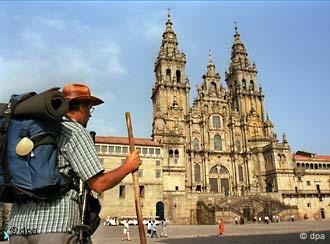Contemporary Pilgrims of Santiago de Compostela:
The History of the Pilgrimage During the 20th and 21st Centuries: The Rise of Tourism:
During the first half of the 20th century, Europe was divided over conflicts that resulted in global and civil wars. While Spain remained neutral during World War I, the 1930s was a turbulent period for the country. When the Spanish Civil War broke out in 1936, the entire country became a war zone divided between Republicans and Fascists. Therefore, all pilgrimages ceased as well as regular church practices, because of the dangerous war zone stretching throughout Spain. As the civil war ended, with victory for Franscico Franco, Spain joined Hitler and Mussolini in World War II. It was not until the late 1950s through the 1970s that the pilgrimage routes could be restored and grow once more in popularity. With the rediscovery of religious and cultural traditions from these traumatic wars, the pilgrimage routes were lost as well as the practice. However, with the general rise of tourism during the 1950s, pilgrimages were marketed as a touristic opportunity. With this, pilgrimages and especially the several routes to Santiago de Compostela, were advertised as opportunities to see European countrysides, towns, and the beautiful cathedral at the end. The tourist industry helps Santiago de Compostela along with the cities along the route like Conques to survive and thrive, much like medieval cities that received traffic for the reliquaries. Of course, there was still the religious appeal to these journeys, but in comparison with the medieval versions, it became more of a personal achievement than a religious necessity. The majority of pilgrims are and continue to be devout Catholics who aim to deepen their faith and spirituality through the physical difficulties of the long journeys.

Pilgrims of Today:
Today, it is not necessary to belong to the faith in order to participate, but all who participate must know about the physical demands of the journey. There is a guide detailing the physical demands as well as the spiritual ones. Those who partake as a religious pilgrim, can follow a spiritual guide that leads them through the various trials they may endure. Overall, the resurgence of the pilgrimage, the Way of St. James, was a result of a broken and destroyed Europe during the mid-20th century, seeking to find stability in its roots and a response to tourism.